Tuesday Triage #57
- TUESDAY TRIAGE #57 by Vadim Drobinin
- On trying again
- Things I enjoyed reading
- 1. Ghosts by Vauhini Vara
- 2. The Economics of OnlyFans by @tdoggyholhol
- 3. The rooms where it happened by Richard Byrne
- 4. Behind the scenes at South Kensington tube station’s escalator replacement project by Ian Mansfield
- 5. The Surprising Benefits of Talking to Strangers by @JoeKeohane
- 6. Convincing Xcode to Map Vim Keys by @brycepauken
- 7. The Mysterious Street Snack That Has Baffled Botanists for Decades by mediabarkha
- 8. Copy-protection for vinyl in the 1970s by @martinbelam
- 9. How Watches Work by Brandon Baines
- 10. Writing great alt text: Emotion matters by @jaffathecake
- Things I didn't know last Tuesday
- 1. Heating lamp
- 2. Calais was a part of England
- 3. Eve teasing
- 4. Wet-bulb temperature
- 5. Country with most tornadoes by area
- 6. Non-brewed condiment
- 7. Mustard balls
- 8. Queen's Evidence
- 9. Apple Records
- 10. Irreversible binomial
- Book of the week
- Thank you and see you in a week!
TUESDAY TRIAGE #57
by Vadim Drobinin ¶
Your weekly crème de la crème of the Internet is here!
17.08.2021 (read in browser)
-
Intro
Whatever is on my mind this week. -
Things I enjoyed reading
Ten-ish articles I found worth reading. -
Things I didn't know last Tuesday
Ten-ish facts I didn't know when I wrote the previous edition. -
Book of the week
Some thoughts on the latest book I've read.
On trying again ¶
Once in every six weeks or so we check out a restaurant that completely changes their tasting menu with the same frequency.
This time it is all about Amalfi coast, before we tried "Circus" and "Shanghai".
Choosing a name for a menu is hard, and I know the drill: some people will be offended or disappointed no matter what you include, as everyone would have different memories and anchors to the past.
Out of seven servings we had, I was really fascinated by a few and that's not too shabby.
Parmesan polenta with glove artichokes, girolle mushrooms, and lardo di colonnata, cured strips of fatback, was my favourite: umami-rich parmesan foam with almost no resistance contrasted with heavy artichoke cubes, sourness of pickled mushrooms cutted through the doughiness of polenta, and a strip of fat rounded everything up.
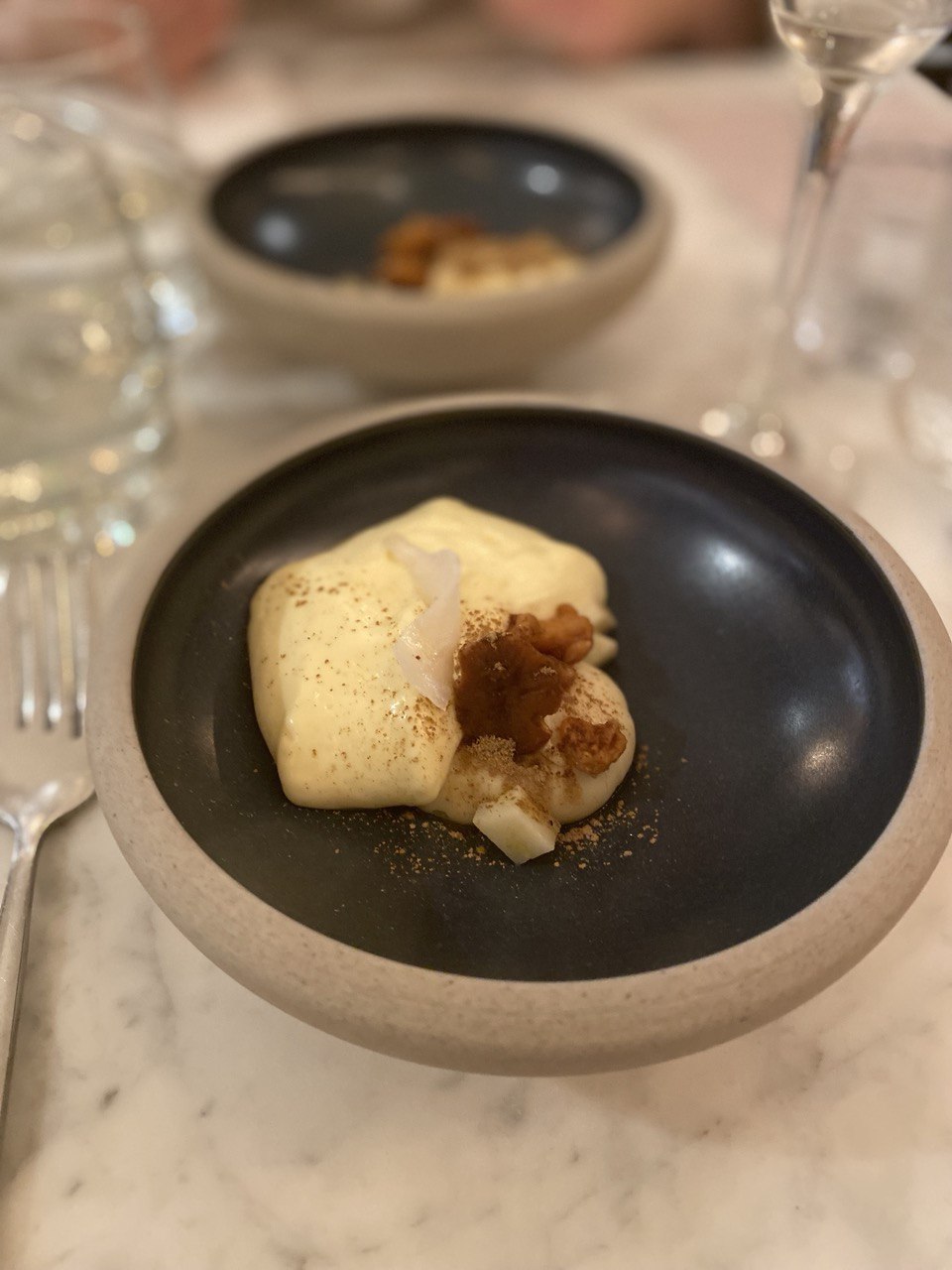
One of the mains was quite nice as well: fillet of pork with some 'nduja, summer squash and smoked onion was greatly balanced.
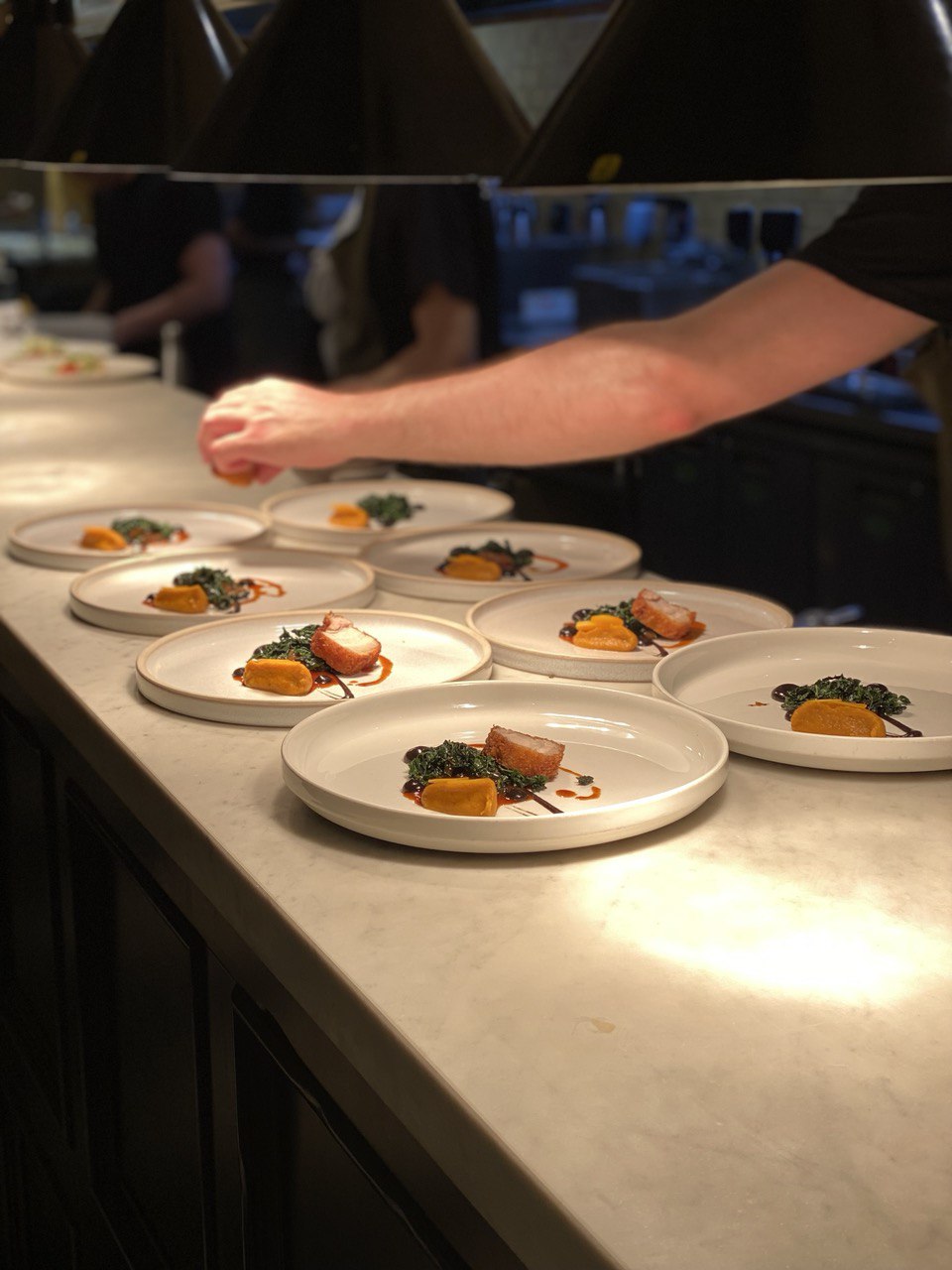
And the dessert served with some sweet wine was great too: lemon delights, mousseline, almond sponge, caramelized white chocolate (so it had a really funny texture), yoghurt, and meringue. Again, the mix of different textures did the trick. Maybe there is something to it, and next time I should pay more attention not only to flavours but also to the textures on the plate.
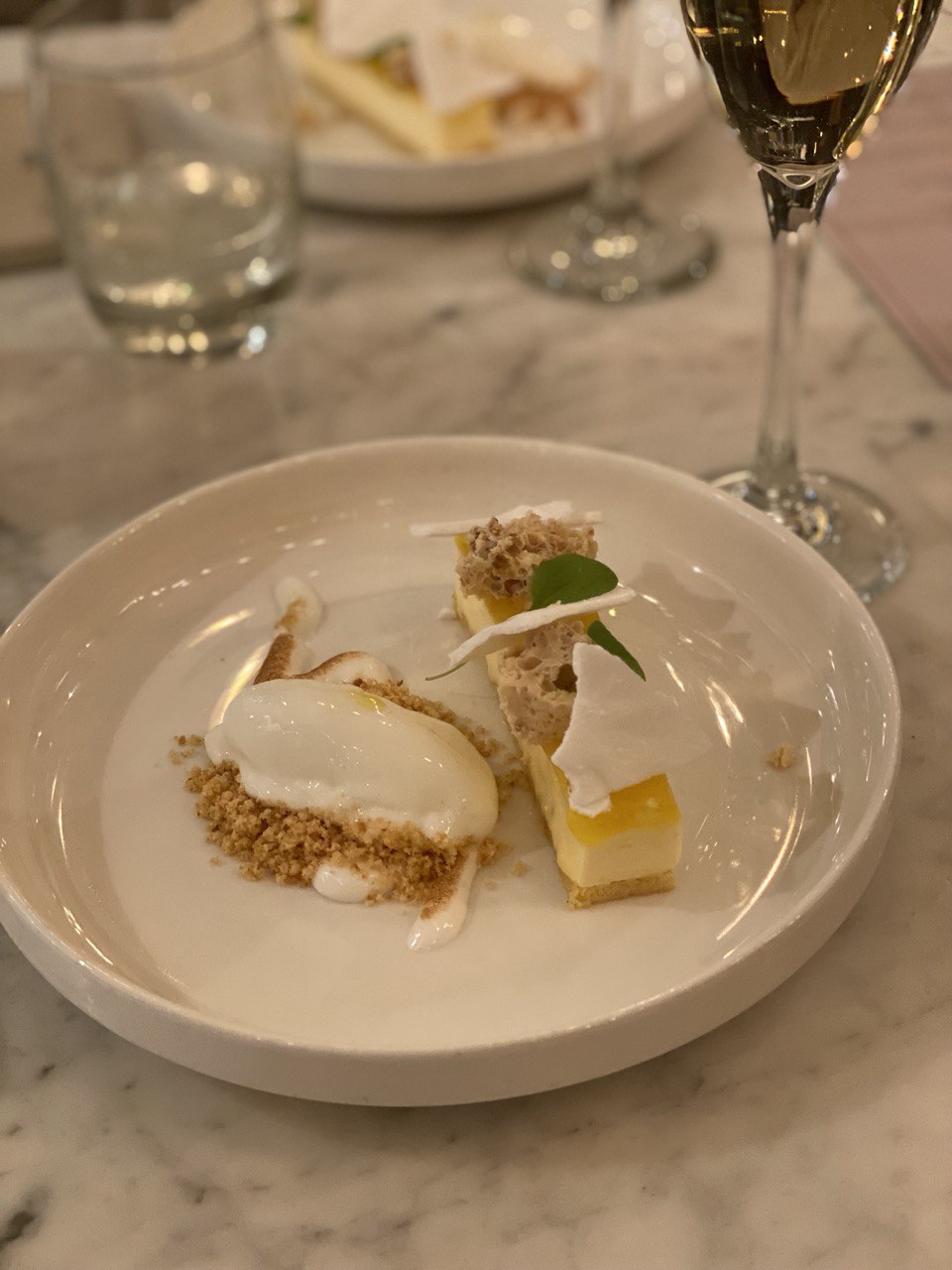
In the meantime I had a chance to try my hand at another few Michelin dishes.
Last week I made Wylie Dufresnes' "sunny-side up", and this week I tried out his recipe for Crème Brûlée Pearls, which involves solidifying the base in a shape of pearls.

I miserably failed at that stage, and even though something got solidified, pearls look a bit different, that's for sure. However, the rest went more or less better (although the caramel might have had a bit more structure to it).
Crème Brûlée pearls and tubes, orange zest, roasted cocoa caramel, and mint.
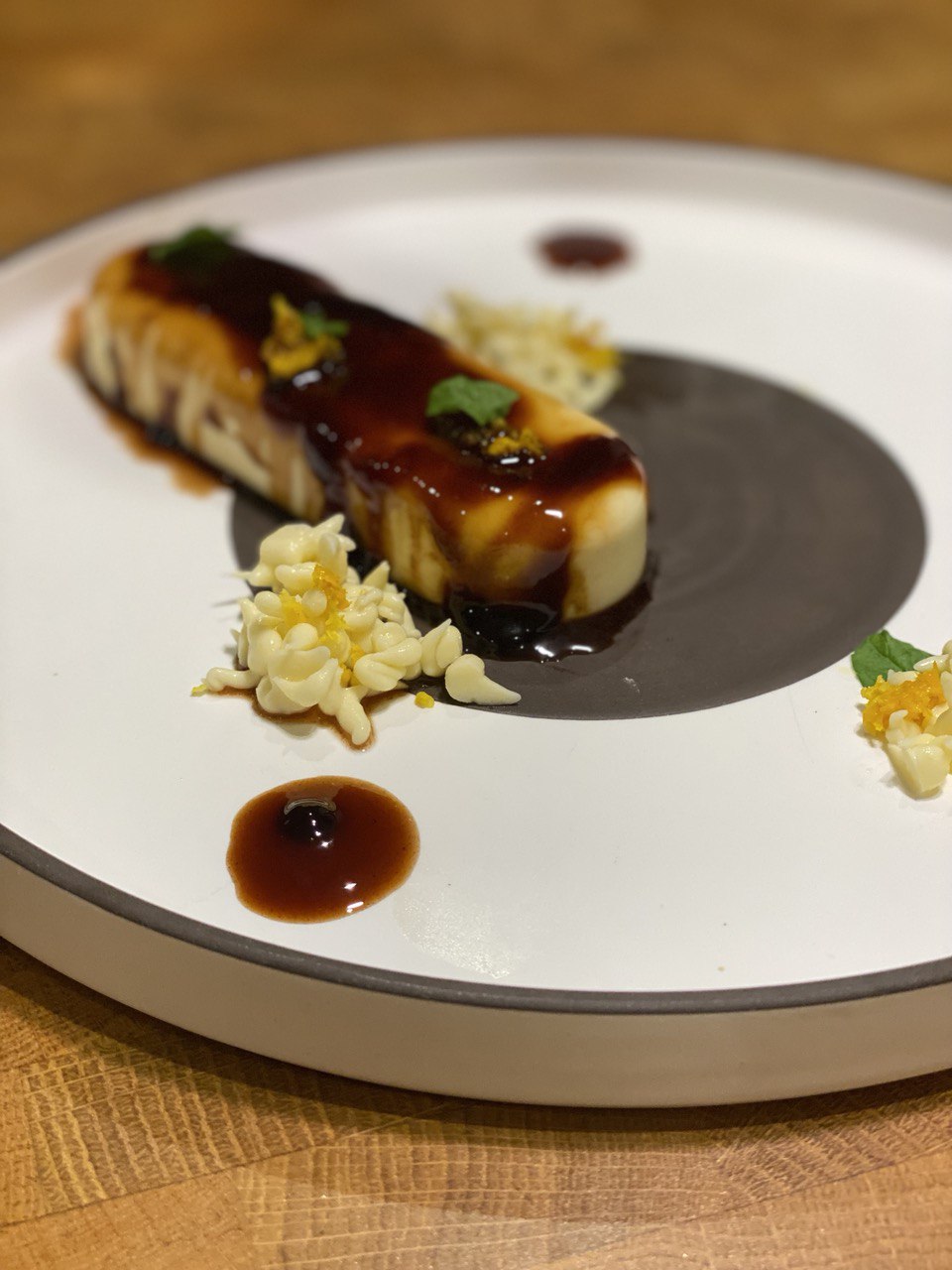
Another chef I came back to is Tom Kerridge. I used one of his recipes to do a rhubarb crumble tartlet not that long ago, so this time I went for another classic dessert, which is rum baba.
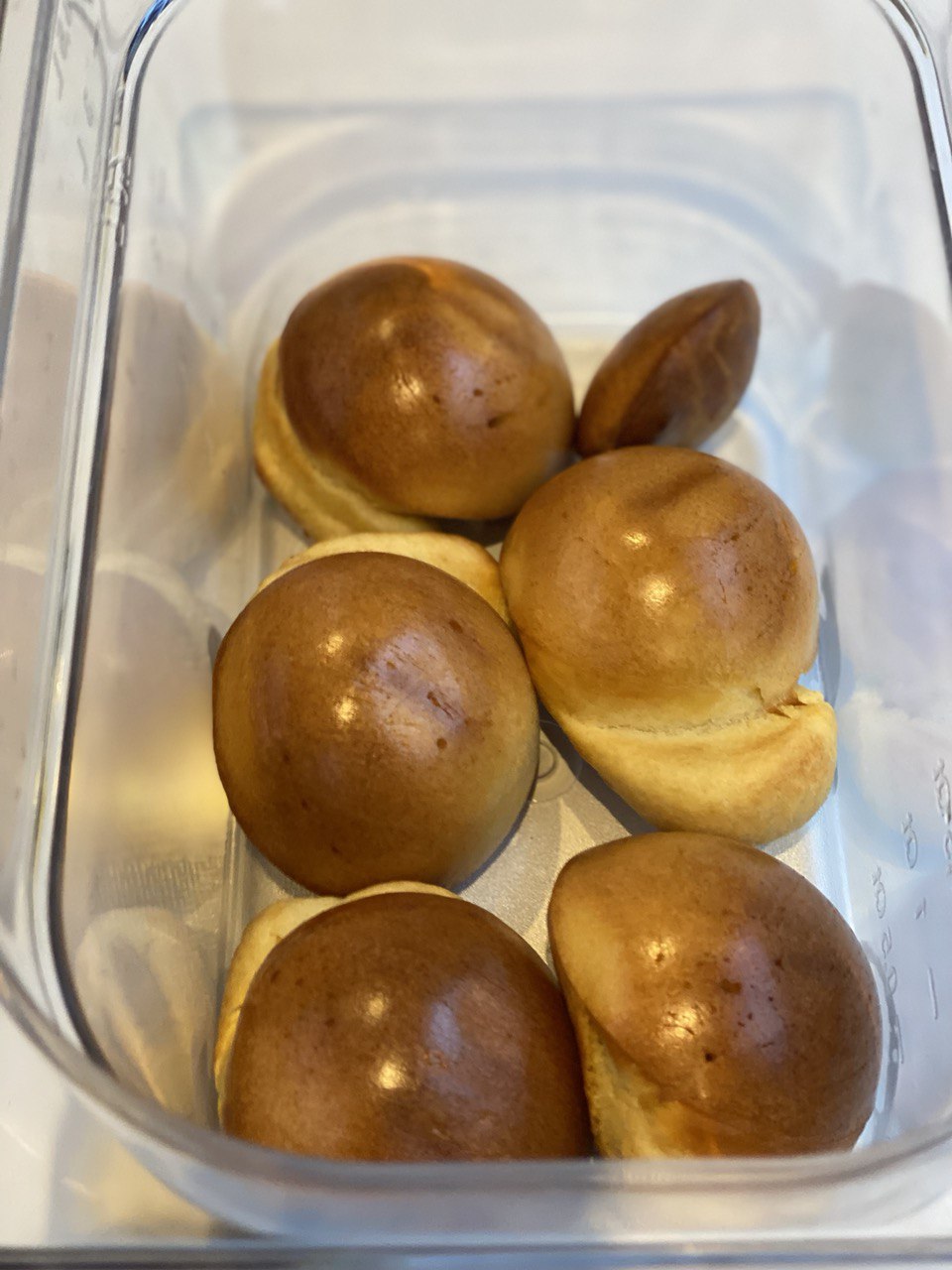
Soaked in rum syrup (I used Dark Matter rum, made in Scotland!), and plated with homemade coconut sorbet, glazed lemon peels, and mango cubes.
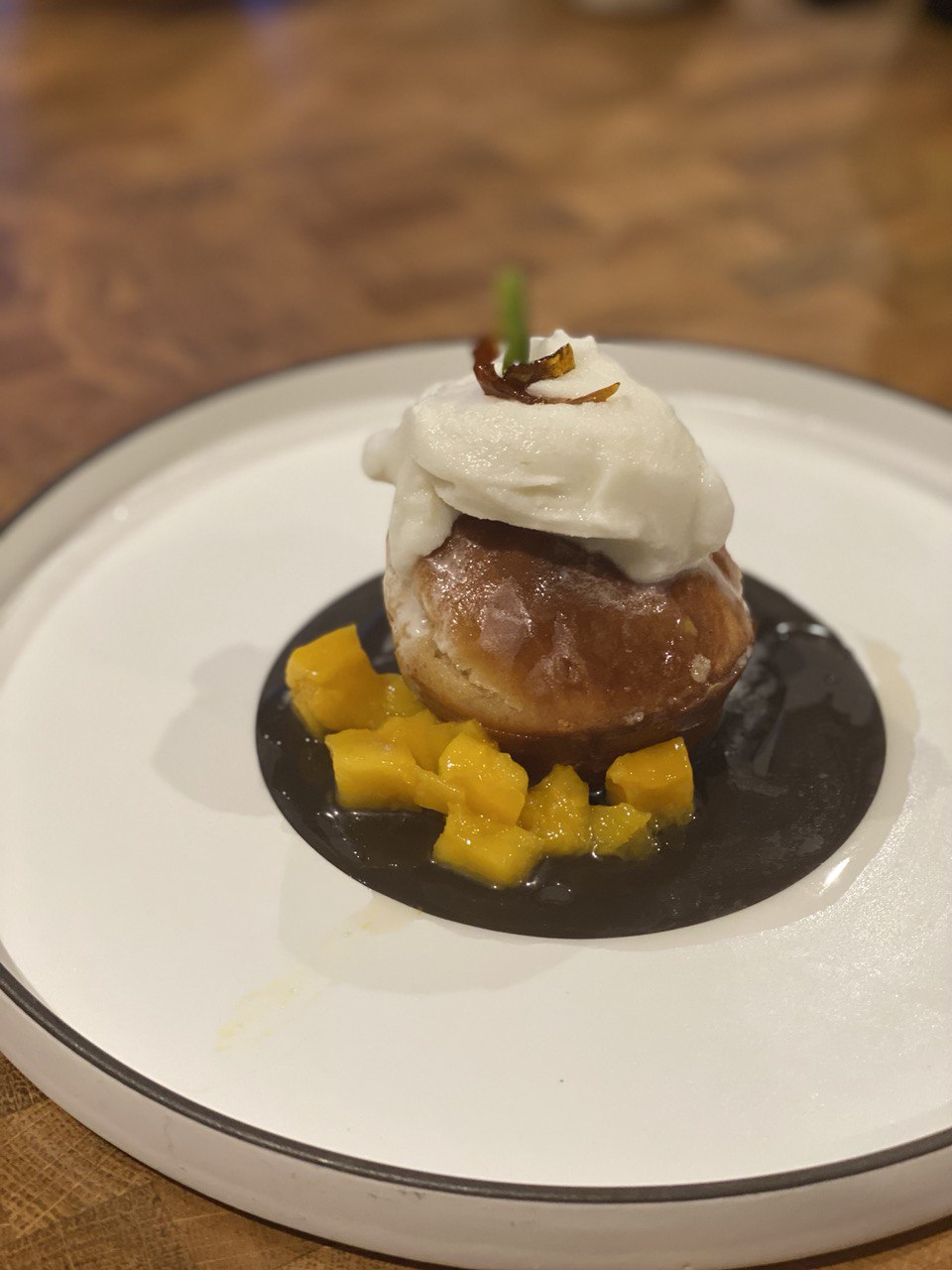
The recipe resulted in twelve servings, so more plating tests are still under way. The latest is that cubed pineapple actually pairs with the dish even better. Also I soaked hot babas with hot syrup, but they got properly infused only by the next day. A lesson learnt, that's for sure.
Things I enjoyed reading ¶
1. Ghosts by Vauhini Vara ¶
Out of everything modern machines are capable of, their success in writing readable text is the most fascinating to me.
There are numerous examples of the bots writing articles, ads, code, or even poems, and yet this example talks about a completely different level of creation as it touches up on something way more personal than a poem generated by a trained model.
I had always avoided writing about my sister’s death. At first, in my reticence, I offered GPT-3 only one brief, somewhat rote sentence about it. The AI matched my canned language; clichés abounded. But as I tried to write more honestly, the AI seemed to be doing the same. It made sense, given that GPT-3 generates its own text based on the language it has been fed: Candor, apparently, begat candor.
Check out the link for the actual example of how it progressed from a few sentences to an actual post, the results are mesmerising.
2. The Economics of OnlyFans by @tdoggyholhol ¶
Despite being a family business, Onlyfans became pretty much known in the last year or so, and yet doesn't get even a fraction of recognition it deserves: mostly for its smart business model.
OnlyFans is actually an even better business model than Airbnb or Uber. As the owner of a rental property, or a gig taxi driver, I can only cater to one group of people at any one time. But as an OnlyFans creator, I can broadcast content to the multitude all at once. Making money on Airbnb or Uber is linear — I always have to do one more ride, or host one more visit. On OnlyFans it’s multiplicative — the same selfie can serve 10 adoring fans or 1000.
This is not the first platform trying to monetise that way, and there are the likes of Patreon and Gumroad too, but this one is quite different anyway, whether it's because of the rules (or their lack) or the flair media tend to give to it since pretty much its very beginning.
3. The rooms where it happened by Richard Byrne ¶
A great idea to show and describe "the rooms where it happened", and to anyone familiar with Hamilton the musical this description would be detailed enough.
The Congress’ work was largely done when Napoleon escaped his exile on Elba and seized power again in 1815, only to be beaten decisively at the Battle of Waterloo in June. Napoleon’s defeat confirmed that a vision to take Europe back to its future – forged by the diplomats who met in Vienna – won the day. But when the balls had ended, the specter of an emerging nationalism untethered from direct imperial rule loomed ominously on the horizon.
For everyone else, do give a chance to the musical, it is great and definitely worth it (sadly this is not a paid recommendation).
4. Behind the scenes at South Kensington tube station’s escalator replacement project by Ian Mansfield ¶
I pass by this station quite often and every time something that big gets closed for that long it feels odd. At least now I know what is going on.
In most stations, when escalators need replacing, there is enough space to allow one to be taken out of action while passengers use stairs to go down and the other escalators to go up — but at South Kensington that might have lead to overcrowding at the lower levels during busy periods where there is very limited space, and there’s no way they can take the upper escalators out without diverting people via the already very busy Circle/District line stairs.
Also it's quite odd to look at the Tube-related dates and realize that it was built not long after St. Petersburg was founded.
5. The Surprising Benefits of Talking to Strangers by @JoeKeohane ¶
A nice summary of researches dedicated to learning how we interact with strangers.
Other researchers have come to similar conclusions. In a different experiment devised by the University of Chicago psychologist Nicholas Epley and his then-student Juliana Schroeder, a group of people instructed to speak with strangers on mass transit reported a significantly more positive, enjoyable commute than a group of those who didn’t. On average, conversations lasted a whopping 14.2 minutes, and the talkers overwhelmingly liked the strangers they’d spoken with. People of all personality types had a good time.
I mostly consider strangers (especially on the Tube) to be mildly alarming and dangerous just in case, but that doesn't dismiss the fact that pretty much every single conversation I ever had with a stranger was a pleasent experience (maybe because I remember only the ones I initiated myself).
6. Convincing Xcode to Map Vim Keys by @brycepauken ¶
Not for the light hearted, here is a deep dive into reverse-engineering how Xcode deals with its vim mode, and then patching its behaviour to map some keys.
Now that we have even the smallest insight into what the control flow for a vim command looks like, it's clear that we're probably not going to be able to understand the whole system without a lot of effort: there are events, event consumers, event consumer contexts, commands, command interfaces, command handlers… I'd probably have trouble wrapping my head around it even with source code & documentation.
In the meantime I will probably keep using the vim plugin for Xcode. It is not as good, and calls for re-signing the whole app after every update, but at least I don't need to use a disassembler.
7. The Mysterious Street Snack That Has Baffled Botanists for Decades by mediabarkha ¶
One would think that in 2021 we know pretty much everything there is to know about food, especially sold comercially. However, in India there is a snack scientists are not sure about.
I contacted a wood scientist, a professor of food science, and a Siddha practitioner, each from my state. They hadn’t seen the tree. I pivoted my search to another state in the south, Andhra Pradesh. I called up its tribal department, but got no leads. Then my messages to the head of the biodiversity board were met with silence. I spoke to a botany researcher who had studied the tree, only to learn he had never seen it in person.
Judging by the article, most likely it is some part of agave, but the DNA test is yet to confirm it.
8. Copy-protection for vinyl in the 1970s by @martinbelam ¶
Recently I mentioned jazz on bones and it got me thinking whether anyone tried to protect vinyl from copying.
Magic Alex added a 20-kilohertz tone to the music, a frequency just above human hearing. But when the signal was copied onto tape, it interfered with the similarly high "bias frequency" which analogue tape recorders use to mobilise the magnetic particles in recording tape. The two signals produced a lower "beat frequency" that sounded like a whistle.
Sadly, despite sounding like a really smart idea, it didn't work in the real world (but worked great in a lab), so at some point companies gave up on that.
9. How Watches Work by Brandon Baines ¶
An unexpectedly detailed guide into the insides of watches, full of great illustrations as well.
In the early 1920s, British watchmaker and former soldier John Hardwood pioneered the first automatic wristwatch, receiving a patent for its design in 1924. Harwood’s watch used a hammer that rotated about 230 degrees to transfer kinetic power through the ratchet wheel to the mainspring. Inspired by the way a seesaw bounces off the ground, Harwood’s unidirectional winding weight bounced off of spring-loaded bumpers. Clockwise movement wound the watch, while counter-clockwise movement idled the winding mechanism. These had a power reserve of roughly 12 hours.
I used to enjoy wearing an automatic watch but quickly realised that modern technologies might look uglier but are way more convenient to use. Also I never enjoyed the 12h clock face, so don't miss it at all.
10. Writing great alt text: Emotion matters by @jaffathecake ¶
Something I didn't even think about, although seen quite a few times: alt texts for images. Back then these texts were tremendously helpful with slow internet, as one could know what is pictured without spending hundreds of dollars on the network. Today it is more of an accessibility tool, and sadly it makes it way less popular.
In the context of a conference website, if the speaker is talking about JavaScript performance it seems unnecessary to bring race into it. But if the speaker is talking about their experience of prejudice in the tech industry, that changes the context.
Generally, we get speakers to write their own bios for conference sites. Since they choose how to be represented in the bio, it seems sensible to ask them to write their avatar alt text too.
The author walks through a few great examples on using alt to give the right information instead of shifting the focus, and that was inspiring enough to put some time aside to make sure images in this newsletter have more appropriate descriptions.
Things I didn't know last Tuesday ¶
1. Heating lamp ¶
I never paid much attention to lamps in restaurants, so learnt only now that those retractable lamps they move closer to plates not just signal to the front of the house that orders are ready to get picked up, but also maintain the correct temperature.
Heat lamps are commonly used to keep plated food warm for short periods of time until it’s taken to the customer. Heat lamps help already hot foods stay hot, holding proper, safe temperatures for a limited amount of time.
The lamp located within 12 inches from the plate can maintain food at 60ºC pretty much indefinitely.
Now I need a few of these at home.
2. Calais was a part of England ¶
Who'd think that a French city on the other side of the channel used to be a part of England for a few centuries?
Calais came under English control after Edward III of England captured the city in 1347, followed by a treaty in 1360 that formally assigned Calais to English rule. Calais grew into a thriving centre for wool production, and came to be called the "brightest jewel in the English crown" owing to its great importance as the gateway for the tin, lead, lace and wool trades (or "staples"). Calais remained under English control until its capture by France in 1558.
Is there any party keen on bringing it back? That'd be neat.

3. Eve teasing ¶
Came across this term in an article:
Eve teasing is a euphemism, primarily occurring in Indian English, used for public sexual harassment or sexual assault of women by men.
Apparently the name "Eve" comes from the Bible's creation story concerning Adam and Eve, which seems quite odd.
4. Wet-bulb temperature ¶
Given all the heat waves coming around us, I got more familiar with the terminology.
The wet-bulb temperature is the temperature read by a thermometer covered in water-soaked cloth over which air is passed.
Even those heat-tolerant cannot proceed with their day-to-day outdoor activities at wet-bulb temperature of 32°C (90 °F). And the theoretical survival limit in a shade with unlimited amount of water is the wet-bulb temperature of 35 °C (95 °F).
Not cool at all.
5. Country with most tornadoes by area ¶
Judging by the Guinness World Records book, England has the most tornadoes by area in the world.
Between 1980 and 2012, England experienced 2.2 tornadoes per year per 10,000 square kilometres (3,861 square miles) – which equates to one per every 4,545 square kilometres (1,754 square miles) annually. By comparison, the entire USA (including the non-contiguous states of Alaska and Hawaii) experienced 1.3 tornadoes annually per the same area – or one per 7,693 square kilometres (2,970 square miles).
They're mostly quite tiny but anyway given there are almost no rains at least we have tornadoes.
6. Non-brewed condiment ¶
This one was a shocker for me.
If I get chips in a chippy, I always get them with salt and vinegar on top.
The vinegar needs to be fermented, and this is a time-consuming process that makes it more expensive.
So many chippies use something called a non-brewed condiment, which is meant to replicate flavours of vinegar by mixing water with an acid and colourings.
Non-brewed condiment is a malt vinegar substitute created with water, acetic acid, flavourings and often caramel colour, sometimes used in fish and chip shops in the United Kingdom and Ireland.
At least that explains why I can not reproduce the flavour at home.
7. Mustard balls ¶
Speaking about condiments, mustard used to be rolled into balls for easier storage and transportation.
The town of Tewkesbury was well known for its high-quality mustard balls, originally made with ground mustard mixed with horseradish and dried for storage, which were then exported to London and other parts of the country, and are even mentioned in William Shakespeare's play King Henry the Fourth, Part II.
These days they still sell the balls in that town, but as it is mostly for tourists they are wrapped into edible gold leaves.
8. Queen's Evidence ¶
As the monarch is head of the legal system their testimony can't be called into question if used in a court.
They could either let the trial continue, with Mr Burrell giving his version of the conversation but with the prosecution unable to challenge it because the Queen could not be compelled to give evidence.
Essentially, one lawyer said, the accused would “have a free rein” and there would be a near-certainty of an acquittal.
So one day Her Majesty actually came to the court and they didn't really have a choice.
9. Apple Records ¶
The Beatles created a record company called Apple Records in 1968.
Since 1978 it has had many legal battles with Apple Inc, initially due to trademark infringement, and later because Apple Records claimed Apple Inc violated an agreement to stay out of the music business.
Apple Computer “agreed that they would not use or register their marks for any equipment which had been … ‘specifically adapted for use in the recording or reproduction of music,’” Beatles attorney Nicholas Valner told the Los Angeles Times in 1991, after the trial had already dragged on for more than nine months. “In other words, if they made a computer that could do that, they couldn’t call it an Apple. They’d have to call it an Orange or something like that.”
Can't really blame any of them: in 1978 probably no one thought of Apple as a music business company.
10. Irreversible binomial ¶
There is a bunch of English words that can't be swapped in a sentence.
Some English words have become obsolete in general but are still found in an irreversible binomial. For example, spick in spick and span is a fossil word that never appears outside the phrase.
More common examples would be "mac and cheese" (we can't say "cheese and mac") or "rock and roll". A way bigger list is behind the link.
Book of the week ¶
Cooking is simple for it is just sticking to a recipe.
Surprisingly, people rarely get exciting about a recipe carefully followed.
Michelin stars exist not for places capable of boiling eggs (although that is quite hard to nail).
The key to a successful dish is creativity, and that is not so simple.
As Metallica drummer Lars Ulrich writes in a foreword to René Redzepi's A work in Progress:
Look, creativity is creating something from nothing. Ok, that may be a little black and white. Obviously it can also be a continuation of a starting point further along than nothing, a place you may have visited before. It comes in all shapes and sizes. Any idea, if you think about it, is potentially creative. Whether it's about what colour to put on the canvas next, what note to end a musical riff on, what words or nuances to put into that poem you've been revisiting for months or how to prepare hassel nuts or leek roots in new, exciting, uncharted ways, are all part and parcel of creativity.
As stated, there are no boundaries, there are no rules, there are no limits. Clearly there's a starting point and often, an end point, but what dictates when that end point is reached? Well, in searching for the definitive answer yet again, I can only arrive at one overriding fact; it dictates when it is complete. With maybe a smidgeon of help or guidance from its creator.
René Redzepi is probably one of the most influental chefs of this century, and despite being more known for Noma the restaurant and its fermentation guide, I still think this book (published half a decade earlier) is a way more valuable piece of work, not because of its collection of recipes, but due to the opportunity to glimpse into the mind of someone brave enough to serve milk skins as a course (albeit with a potato mash and whey sauce).
At the same time, just reading books written by creative people won't make the reader as creative. But I honestly believe it could provide enough pieces of a puzzle to fake such approach until you could actually make it: I always try to stick to a recipe as close as possible the first time I cook it, and then try to do something odd with it if everything went smooth.
Wonder if that works with programming too.
Thank you and see you in a week! ¶
If you have any questions, or want to suggest a link for the next newsletter, please drop me a message on Twitter or reply to this email.
Cheers! 🍸